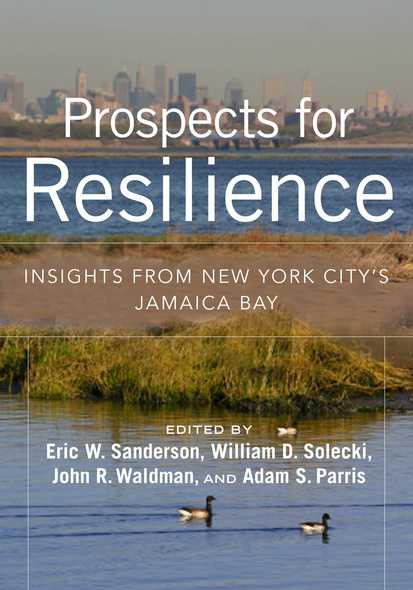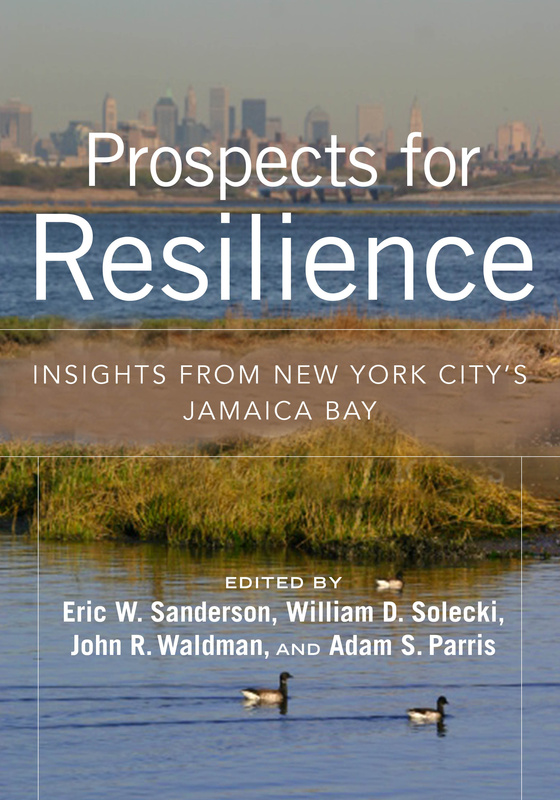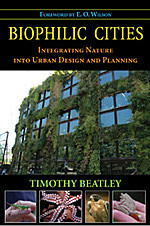
304 pages, 7 x 10
one 8 page insert; 50 photos
Paperback
Release Date:17 Nov 2016
ISBN:9781610917339
Prospects for Resilience
Insights from New York City's Jamaica Bay
Island Press
Given the realities of climate change and sea-level rise, coastal cities around the world are struggling with questions of resilience. Resilience, at its core, is about desirable states of the urban social-ecological system and understanding how to sustain those states in an uncertain and tumultuous future. How do physical conditions, ecological processes, social objectives, human politics, and history shape the prospects for resilience? Most books set out “the answer.” This book sets out a process of grappling with holistic resilience from multiple perspectives, drawing on the insights and experiences of more than fifty scholars and practitioners working together to make Jamaica Bay in New York City an example for the world.
Prospects for Resilience establishes a framework for understanding resilience practice in urban watersheds. Using Jamaica Bay—the largest contiguous natural area in New York, home to millions of New Yorkers, and a hub of global air travel with John F. Kennedy International Airport—the authors demonstrate how various components of social-ecological systems interact, ranging from climatic factors to plant populations to human demographics. They also highlight essential tools for creating resilient watersheds, including monitoring and identifying system indicators; computer modeling; green infrastructure; and decision science methods. Finally, they look at the role and importance of a “boundary organization” like the new Science and Resilience Institute at Jamaica Bay in coordinating and facilitating resilience work, and consider significant research questions and prospects for the future of urban watersheds.
Prospects for Resilience sets forth an essential foundation of information and advice for researchers, urban planners, students and others who need to create more resilient cities that work with, not against, nature.
Prospects for Resilience establishes a framework for understanding resilience practice in urban watersheds. Using Jamaica Bay—the largest contiguous natural area in New York, home to millions of New Yorkers, and a hub of global air travel with John F. Kennedy International Airport—the authors demonstrate how various components of social-ecological systems interact, ranging from climatic factors to plant populations to human demographics. They also highlight essential tools for creating resilient watersheds, including monitoring and identifying system indicators; computer modeling; green infrastructure; and decision science methods. Finally, they look at the role and importance of a “boundary organization” like the new Science and Resilience Institute at Jamaica Bay in coordinating and facilitating resilience work, and consider significant research questions and prospects for the future of urban watersheds.
Prospects for Resilience sets forth an essential foundation of information and advice for researchers, urban planners, students and others who need to create more resilient cities that work with, not against, nature.
Prospects for Resilience centrally positions the Jamaica Bay watershed as a social-ecological system and details the interactions among wetlands, water, and people and commerce in a way that is often discussed but rare in practice. Resilience planning and practice at this broad scale is not easy, but the framework outlined in this volume should provide a solid foundation for years to come.
Increasing resilience means collaborating across all levels, across interests and borders, across the world. It asks for inspiration and information with better research, data, shared knowledge, and innovation. With the world at a tipping point in its climate change approach, Prospects for Resilience provides this kind of critical information, inspiring communities and showing how to increase their capacity for resilience.
In Prospects for Resilience, 52 contributors from various disciplines came together to produce a dozen papers assessing how resilience can be developed in and around Jamaica Bay. The topic sounds cumbersome, and in some ways, it is, but the questions are simple and can be asked in many places: 'What does it take to make a coastal city like New York resilient? How do we understand disturbances in the context of history and nature, and how do we enhance the ability of people and nature to recover after them?'…The contributors seek to encompass everything from the quality of sediment in the bay to the nearby human communities...the result is not quick reading; the foundations are being laid.'
The risks of climate change are forcing a re-evaluation of the ways we live, work, and play in the twenty-first century. The groundbreaking, collaborative research being done in Jamaica Bay, insightfully presented in Prospects for Resilience, is helping us prepare for this future through our own OneNYC resilience program. For what we do in Jamaica Bay will not only help the bay but, if done right, can have a regional, national, and even global impact in the fight against climate change.
A welcome contribution to social-ecological system restoration especially of coastal areas. It demonstrates how complex ecological restoration will become by taking into account social drivers and issues...However, it is also clear that the book is just a first step and that resilience science is, just as resilience practice, a learning process in which a lot of steps have still to be taken. The volume will surely contribute to the way forward.
Eric W. Sanderson is a senior conservation ecologist at the Wildlife Conservation Society. Dr. Sanderson is the best-selling author of Mannahatta: A Natural History of New York City (2009).
William Solecki is a professor of geography at Hunter College, CUNY and served as the Interim Executive Director of the Science and Resilience Institute at Jamaica Bay for its first two years. Dr. Solecki is also a lead author of the IPCC Fifth Assessment Group II, Urban Areas Chapter.
John R. Waldman is a professor of biology at Queens College, CUNY. Prior to joining Queens College, Dr. Waldman worked for the Hudson River Foundation for Science and Environmental Research for 20 years.
Adam Parris is the executive director of the Science and Resilience Institute at Jamaica Bay, hosted at Brooklyn College.
William Solecki is a professor of geography at Hunter College, CUNY and served as the Interim Executive Director of the Science and Resilience Institute at Jamaica Bay for its first two years. Dr. Solecki is also a lead author of the IPCC Fifth Assessment Group II, Urban Areas Chapter.
John R. Waldman is a professor of biology at Queens College, CUNY. Prior to joining Queens College, Dr. Waldman worked for the Hudson River Foundation for Science and Environmental Research for 20 years.
Adam Parris is the executive director of the Science and Resilience Institute at Jamaica Bay, hosted at Brooklyn College.
Foreword
[List of Contributors]
[List of Figures]
Part I: Introduction to Resilience in Jamaica Bay
Chapter 1: Introduction: Why Prospects for Jamaica Bay
Chapter 2: Resilience Practice in Urban Watersheds
Part II: Social-ecological Systems of Jamaica Bay
Chapter 3: Dynamics of the Biophysical Systems of Jamaica Bay
Chapter 4: Change and Resilience of Jamaica Bay's Ecological Systems
Chapter 5: Social-Ecological System Transformation in Jamaica Bay
Part III: Tools for Resilience Practice
Chapter 6: Resilience Indicators and Monitoring
Chapter 7: Computational Modelling of the Jamaica Bay System
Chapter 8: Green Infrastructure as a Climate Change Resiliency Strategy
Chapter 9: Application of Decision Science to Resilience Management in Jamaica Bay
Chapter 10: Building Community Resilience Practice Capacity
Part IV: Prospects for Resilience in Jamaica Bay
Chapter 11: Resilience Practice and Process and Product
Glossary
Acknowledgments
Index
[List of Contributors]
[List of Figures]
Part I: Introduction to Resilience in Jamaica Bay
Chapter 1: Introduction: Why Prospects for Jamaica Bay
Chapter 2: Resilience Practice in Urban Watersheds
Part II: Social-ecological Systems of Jamaica Bay
Chapter 3: Dynamics of the Biophysical Systems of Jamaica Bay
Chapter 4: Change and Resilience of Jamaica Bay's Ecological Systems
Chapter 5: Social-Ecological System Transformation in Jamaica Bay
Part III: Tools for Resilience Practice
Chapter 6: Resilience Indicators and Monitoring
Chapter 7: Computational Modelling of the Jamaica Bay System
Chapter 8: Green Infrastructure as a Climate Change Resiliency Strategy
Chapter 9: Application of Decision Science to Resilience Management in Jamaica Bay
Chapter 10: Building Community Resilience Practice Capacity
Part IV: Prospects for Resilience in Jamaica Bay
Chapter 11: Resilience Practice and Process and Product
Glossary
Acknowledgments
Index






